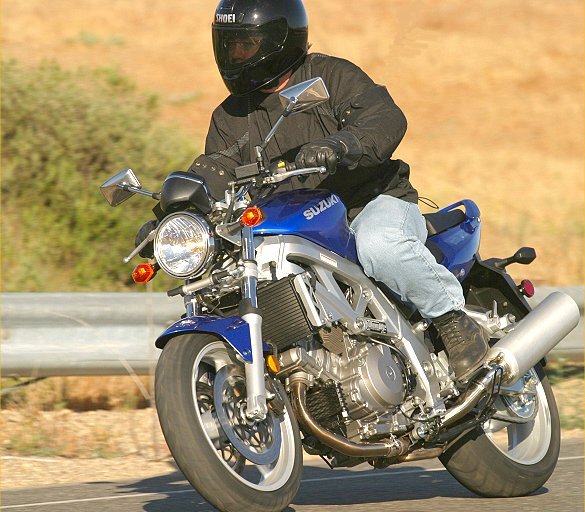
When Suzuki introduced the SV650 several years ago, it hit a sweet spot in the market. A small, light, affordable, do-it-all, standard-style motorcycle, with good performance and the character of a v-twin engine. The bike instantly appealed to a broad range of riders — from novices to experts. The bike was (and remains) practical, reliable, cheap, and fun.
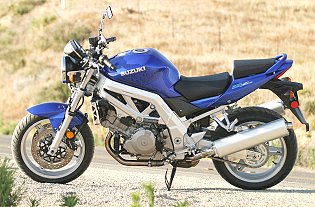
When the SV650 was introduced, Suzuki was in possession of one of the great v-twin 1000cc street bike motors, then found in the TL1000R sport bike and the TL1000S semi-naked bike (featuring a unique and, ultimately disfavored rotary damping system for the rear suspension). Almost immediately, the call went out to Suzuki to produce a 1000cc version of the popular SV650. Suzuki did not appear to listen for several years, but, lo and behold, the SV1000 is a reality for 2003.
For several months now, the SV1000S (with its small fairing, dual headlights and sportier ergonomics) has been available here in the United States — both to the press and to customers at Suzuki dealerships. Suzuki made a decision to allocate manufacturing resources towards the 1000S model, and bring the naked SV1000 to market a bit later. We did not ride, or review, the SV1000S, preferring to wait for the naked version of the bike.
Well, Suzuki began receiving test units for the American press a short while ago, and we got our hands on an SV1000 naked for about a week (not long enough, really). Opting to test one of the first SV1000 nakeds in the U.S., rather than wait to ride a unit that we could hang onto a bit longer, this report is somewhat of a hybrid between a “first ride” and a “ride review”.
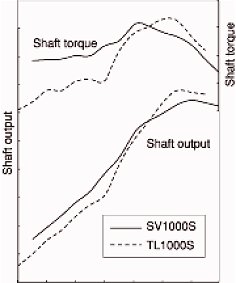
Although the SV1000 utilizes the same engine as prior 1000cc v-twin Suzukis (the precise displacement is 996cc), plenty of new technology was thrown at this motor for use in the SV. With roughly 300 changes, Suzuki describes the 90 degree v-twin in the SV as “thoroughly evolved and refined“.
Compared to the TL1000S, intake valves have gone from 40mm to 36mm in size, providing a big boost in low-end and mid-range power without much sacrifice in top-end power. The fuel injected SV is fed by Suzuki’s dual throttle valve system controlled by a 32 bit CPU.
This powerful computer brain keeps track of a number of performance criteria, including throttle position and even crank position, which contribute to more precise metering of fuel injection volume and ignition timing. Cam profile is also changed from the TL1000S, improving power output in the low-end and mid-range. Basically, Suzuki’s goal for the engine was to smooth power output, without sacrificing much from the top-end of the TL1000S. Suzuki provided the comparison dyno chart illustration to show that they came pretty close to achieving their goal — greatly improved low-end and mid-range, smoother transition from low-end to top-end, and only a minor loss of top-end peak power.
Suzuki also made countless changes aimed at reducing weight in the engine, such as going to single valve springs (the TL1000S had double valve springs), aluminum valve spring retainers, smaller cam chain (which allows a related reduction in the width of the intermediate gear and idler gear), forged pistons (versus the TL1000S cast pistons), tempered conrods (30 grams lighter), etc.
The SV1000 is the first Suzuki to employ a new aluminum cylinder plating technology called Suzuki Advanced Plating (SAP), which, essentially, results in a more consistent surface plating in about 1/5th the time of the conventional immersion plating method. Apparently, this results in reduced manufacturing costs, and reduced retail price.
The six-speed, close-ratio transmission used in the SV1000 is identical, in terms of gear ratios, to that used in the TL1000S, except that the final drive ratio is lower. A lower final drive ratio means quicker acceleration.
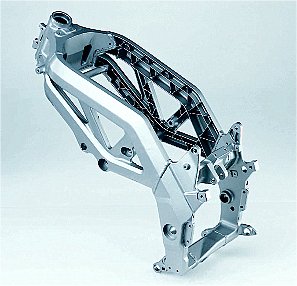
The new frame utilized by the SV1000 is built using a high-vacuum casting technology, which allows Suzuki to minimize weight, while more carefully controlling rigidity at various places in the frame.
Compared to the TL1000S, the SV1000 has a bit longer wheelbase, a bit more conservative geometry, lower seat height and a shorter fuel tank (with closer and higher handlebars).
Suspension consists of beefy, 46mm forks (adjustable for spring preload, compression and rebound damping), as well as a conventional rear shock absorber (compared to the widely disliked rotary system used on the TL1000S) operated through a rising-rate linkage system. The shock is adjustable for spring preload, compression and rebound damping, also.
The four-piston Tokico front brake calipers come directly from the GSX-R750, and they squeeze 310mm discs. The rear, 220mm disc is squeezed by a single-piston caliper.
Suzuki follows the newest trend toward smaller, lighter rear tires, and replaces the TL1000S’ 190-section rear with a 180-section.
Other styling, convenience and instrument features are virtually identical to those found on the 2003 Suzuki SV650, which we reviewed here.

Riding the SV1000 reveals that Suzuki did an excellent job on the motor — achieving precisely what they aimed for. The motor is extremely linear in its power delivery. It pulls well from a stop, and revs smoothly all the way to redline (at 11,000 rpm). I did notice a slight flat spot at about 5,500 rpm, but not too bad, really. This corresponds with dyno charts I have seen, which show a slight dip in the horsepower and torque curves between 5,000 and 6,000 rpm.
Suzuki obviously wanted to make the SV1000 less wheelie-prone than the TL1000S (which was famous for lifting the front wheel . . . sometimes, when you didn’t want it to). The linear power delivery (as opposed to the torque and horsepower spike found on the TL1000S), greater weight bias towards the front end of the motorcycle, and more conservative geometry (with a stock, steering damper — missing from the first-year TL1000S model) calm things down considerably. The front wheel tends to stay planted on mother earth, although it will come up in first gear with a gentle tug on the bars and a squirt of throttle. When the wheel comes back down, the steering geometry and steering damper keep the front end tracking straight. Overall, the SV1000 offers excellent straight-line stability.
The trade-off is a bit heavier, slower steering response. The SV1000 will change directions relatively easily, but it does require more effort than most modern sport bikes (and considerably more effort than its little brother the SV650). Once on its side, however, the SV1000 is composed, and stable. We didn’t have much time to play with suspension settings, but aggressive cornering on the stock settings seemed to unsettle the suspension a bit. Again, not much, and probably something that could be dialed out with the compression damping adjustments available on the fork and shock.
Another thing I didn’t try on the SV1000, but wanted to, was an increase in rear ride height. I thought this might allow the bike to change directions a bit quicker, but increasing preload on the rear shock is a bit more difficult than it is on the SV650 (which has pre-set detents for rear shock spring preload, as opposed to the 1000’s straight, stepless collar). Indeed, the SV1000 owners manual suggests that you go to your dealer to change spring preload on the rear shock (imagine that!).
Overall, the SV1000 felt composed and stable, if not quick at changing directions. Coupled with the extremely linear power delivery, this made the bike very easy to ride, and very confidence inspiring.
The close ratio, six-speed transmission found on the SV1000 works just fine, and six, closely- spaced gears on a 1000cc v-twin with an extremely broad power range is, arguably, overkill. There is definitely a gear for every occasion, and the torque spread on the SV1000 frequently allows you to leave the bike in a single gear.
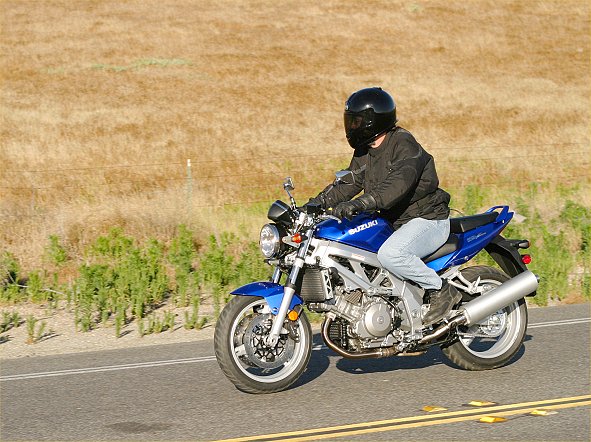
I like the style of the SV1000, and many of the detail features (again, reference our SV650 review). I was somewhat disappointed in the ergonomics, however, The SV1000 has fairly aggressive ergonomics for a naked bike. As delivered, the bars felt a bit low and far away, and the foot pegs a bit high. Basically, I expected the naked version of the SV1000 to provide a more upright seating position, and a bit more generous leg room. Since Suzuki offers a “sportier” version of the SV, the 1000S, why not provide much more relaxed ergonomics on the naked bike (more like the naked SV650, for instance)? In any event, the bar position can be changed quickly, and relatively cheaply, with an aftermarket bar.
The instrumentation on the SV1000 is thorough, and legible, and identical to the SV650. We didn’t have the bike long enough to come up with a reasonably precise estimate of fuel range, but mileage in the high 30s should be easily achievable, and perhaps a bit more. The SV1000 has a fuel tank capacity of 4.7 gallons, and a theoretical range in the neighborhood of 170 miles.
I don’t want to forget the brakes. The four-piston calipers derived from the GSX-R750 are, as you might expect, very powerful for this class of motorcycle. At first, I felt that the brakes did not provide much feedback. However, after more saddle time, I was happy with the amount of feedback from the front brake. Sometimes, powerful front brakes (and these are very powerful) require a fair amount of practice to modulate correctly. I never use the rear brake very aggressively on a street bike (only a light dab on the rear brake to reduce fork dive when entering corners), but I didn’t have a problem with the rear binder.
Overall, the 2003 Suzuki SV1000 is a lot of naked bike at an U.S. MSRP of $7999. You won’t find the range of suspension adjustment available on the SV in this price range from any other manufacturer, nor will you find a v-twin motor to rival that of the SV. My criticism of the ergonomics is not significant enough for me to rate this bike anything other than an excellent value, particularly, when the stock bars could be swapped so easily (they are attached like dirt bike bars).
While there may be other v-twin nakeds on the horizon, you will presently have to spend several thousand dollars more to get a v-twin naked with the type of thrust available from the SV. Some riders just have to have a v-twin, and Suzuki has built a competitor to the Italian machines at a much lower price.





